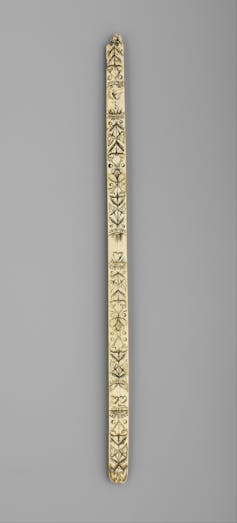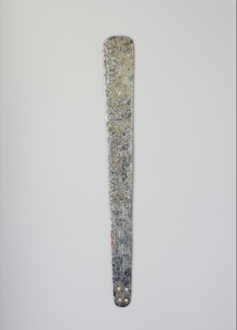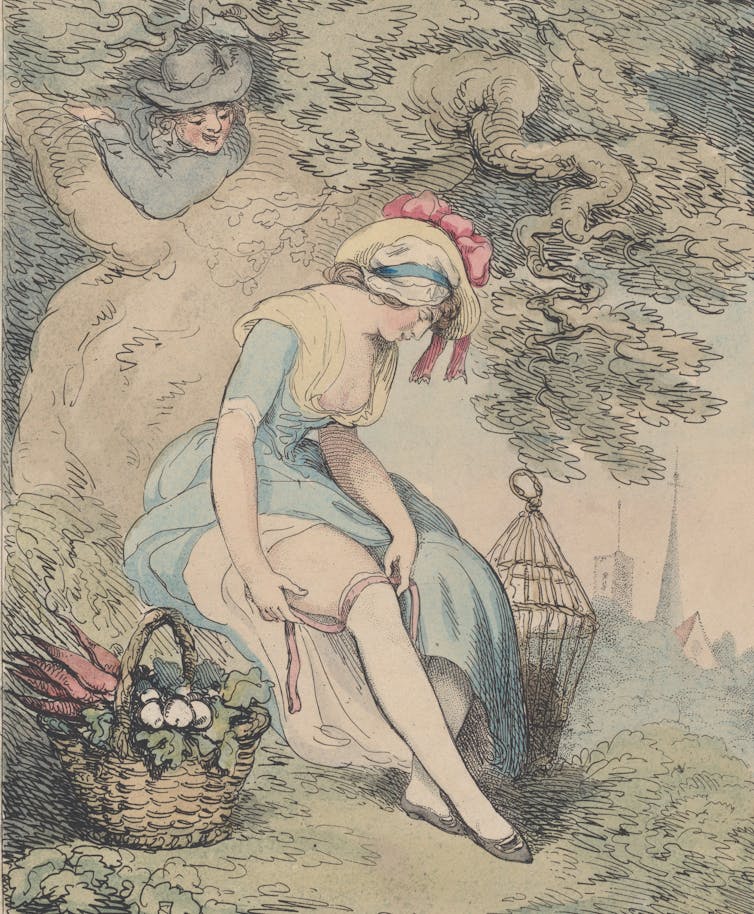Lingerie gross sales in 2020 surged as pandemic lockdowns noticed web shoppers search to flee the mundanity of sweatpants and boost their intercourse lives. Such gross sales will doubtless enhance forward of Valentine’s Day, however the reward of intimate attire shouldn’t be a contemporary phenomenon.
In 17th and 18th-century England and France, intimate objects were additionally gifted throughout courtship or amorous liaisons as tokens of romantic intention and sexual need.
The “busk”, a protracted piece of wooden, steel or whalebone, was positioned right into a stitched channel between layers of cloth in the entrance of corset bodices or stays.
And garters — extra of a novelty merchandise right this moment — were strips of cloth or ribbons tied round a girl’s decrease thigh to maintain her stocking in place.
Both were usually inscribed or embroidered with intimate phrases of love. They were additionally charged with erotic connotations as a result of their intimate place on the feminine physique subsequent to breasts, groins and thighs.
A pair of girls’s garters, England or France, early 19th century, produced from
printed and embroidered silk, steel clasp, and coiled wire.
Los Angeles County Museum of Art
Intimate tokens
In 1684, English poet and playwright Aphra Behn imagined a tree that for years had witnessed couples wooing beneath its branches. Her poem ends when the tree falls to the axe and …
My physique into busks was turned:
Where I nonetheless guard the sacred retailer,
And of Love’s temple preserve the door.

This 17th-century busk is inscribed with a heartfelt poem, to be worn near the bosom.
Gift of Mrs. Edward S. Harkness/The Met Museum, New York.
As busks were destined to take a seat on the physique subsequent to the coronary heart, it was solely becoming that wooden from this tree was used to style them.
Several performs and poems consult with males who purchased or made busks for his or her sweethearts. The sheer quantity of surviving busks that include inscriptions of love testifies to their reputation.
One 17th-century French busk in The Met Museum’s assortment exclaims, “Until Goodbye, My Fire is Pure, Love is United”.
Three engravings correspond with every line: a tear falling onto a barren discipline, two hearts showing in that discipline and lastly a home that the couple would share collectively in marriage with two hearts floating above it.
Similarly, surviving 18th-century garters include embroidered sayings and verses. One 18th-century French pair proclaims, “same hearts, same thoughts”.
Another states, “My motto is to love you, It will never change”.
In February 1660, in the meantime, Samuel Pepys famous in his diary that he despatched his spouse “silk stockings and garters, for her Valentines.”
Read extra:
Dear Valentine, take one other little piece of my coronary heart, or hair
Erotic puns
Although busks and garters were generally given as presents, even on Valentine’s Day they were not socially ostentatious tokens like jewelry.
Their place inside or beneath clothes meant that whereas giving and receiving could possibly be public, the carrying was a matter of intimacy. This was exploited in erotic literature and on the objects themselves.

17th century French busk inscribed with love poetry. Gift of Mrs. Edward S. Harkness, 1930.
Metropolitan Museum of Art, New York
Some inscriptions discovered on busks spoke of males’s jealousy of the busks, giving these inanimate objects voices of their very own.
A 17th-century French busk, engraved with a person’s portrait declares, “He enjoys sweet sighs, this lover / Who would very much like to take my place.” That “place” being between his lover’s breasts.
Like busks, garters additionally contained verses acknowledging their intimate place on the feminine physique. A pair of French embroidered silk garters from 1780 proclaims, “United forever / I die where I cling.”
In this context, “where I cling” refers to a girl’s decrease thighs, which were solely accessible to these most intimate with her. It was additionally a euphemism for an orgasm.
The busk itself might additionally tackle phallic connotations because it was likened to a lover’s erection in bawdy jokes.

A Girl with a Basket and Birdcage Adjusts Her Garter. Thomas Rowlandson, c. 1785-95.
Thomas Rowlandson/Met Museum
By the late 18th century, busks and garters turned much less personalised and started to be produced on a big scale.
They inform the tales of each fickle human hearts and additionally of a altering European tradition that embraced and then commodified love and need — very similar to many Valentine’s presents right this moment.








